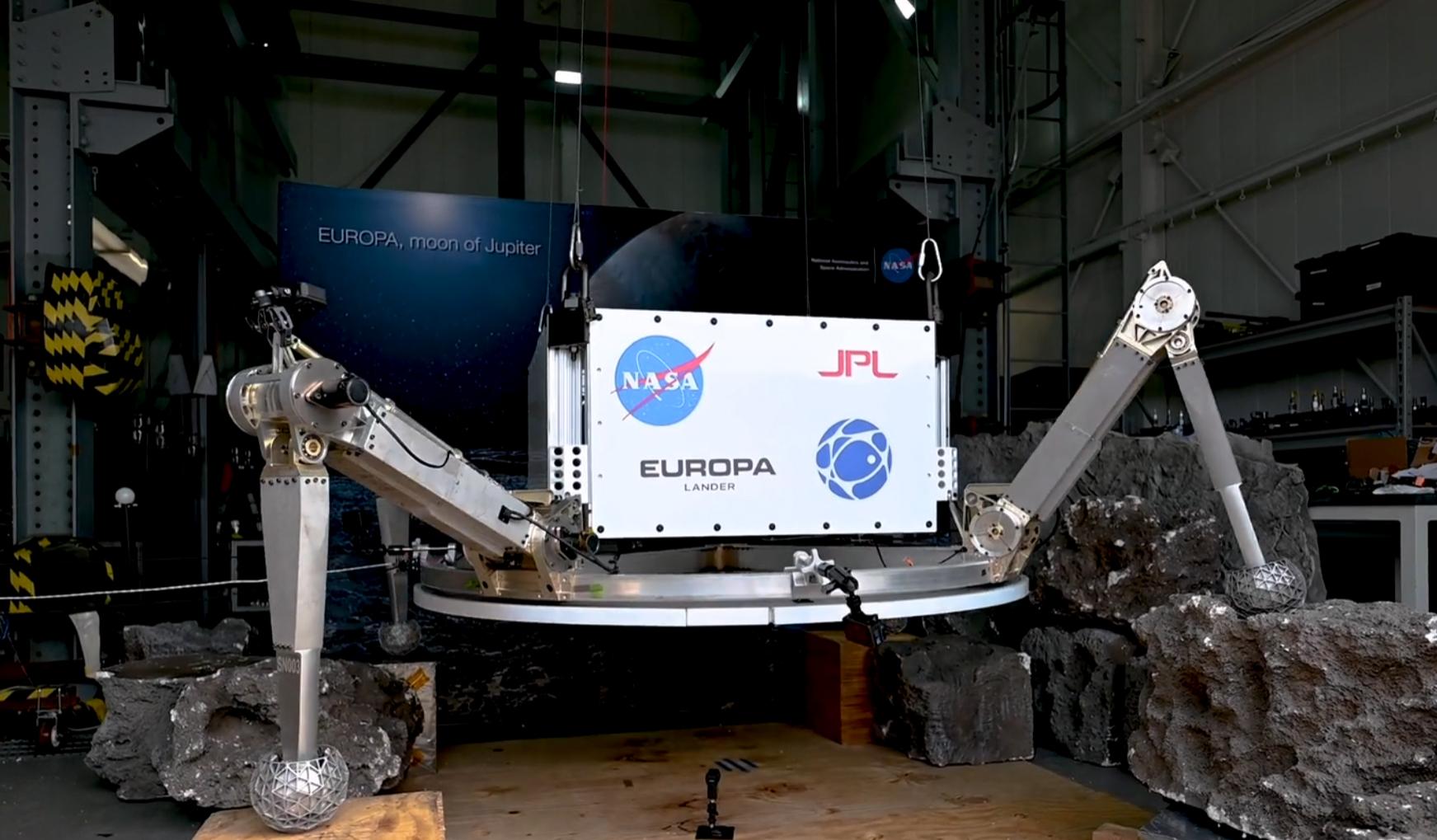In 2024, NASA will launch the Europa Clipper, the long-awaited orbiter mission that will fly to Jupiter (arriving in 2030) to explore its icy moon Europa. Through a series of flybys, the Clipper will survey Europa’s surface and plume activity in the hopes of spotting organic molecules and other potential indications of life (“biosignatures”). If all goes well, NASA plans to send a follow-up mission to land on the surface and examine Europa’s icy sheet and plumes more closely. This proposed mission is aptly named the Europa Lander.
While no date has been set, and the mission is still in the research phase, some significant steps have been taken to get the Europa Lander to the development phase. This past August, engineers at NASA’s Jet Propulsion Laboratory (JPL) in Southern California tested a prototype of this proposed landing system in a simulated environment. This system combines hardware used by previous NASA lander missions and some new elements that will enable a mission to Europa. It also could be adapted to facilitate missions to more “Ocean Worlds” and other celestial bodies in our Solar System.
Since the 1970s, when NASA’s Voyager 1 and 2 probes flew past Jupiter and its system of moons, scientists have been eager to get a closer look at Europa. Several missions have visited Jupiter since, including the NASA-ESA Ulysses probe, which flew past the system in 1992 and 2004. This was followed by the Cassini–Huygens probe that made a flyby in 2000 on its way to Saturn and the New Horizons mission that buzzed the system on its way to the Trans-Neptunian region. However, only two missions have traveled to the system and remained there to study Jupiter and its satellites: the Galileo (1995-2003) and Juno space probes (2016-present).
Thanks to data obtained by the Voyager probes, scientists began to speculate that a liquid ocean might exist beneath Europa’s icy shell. Using planetary models, they further theorized that Europa (and the other Galilean Moons) experienced tidal flexing in its interior resulting from interactions with Jupiter’s powerful gravity. This, they speculated, could lead to hydrothermal activity at the moon’s core-mantle boundary, providing the necessary heat and chemical energy for life. Subsequent missions have only reinforced this suspicion by detecting plume activity, carbon dioxide, and mineral salts on the moon’s surface.
Creating a Europa Lander that can navigate the challenging terrain requires an advanced approach, which NASA engineers are addressing by adapting elements that have worked in the past. This includes the architecture used for the “sky crane” landing system used by NASA’s Curiosity and Perseverance rovers, which relied on parachutes and retro rockets to slow their descent and a pulley system to lower them onto the surface. This system was tested in a simulated environment at NASA’s JPL at Caltech on August 17th and 18th, the highlight of which can be seen in the video above.
The JPL engineers created a simulated propulsive descent stage for their prototype that kept the Europa Lander steady as four bridles lowered it. The Lander has four legs, each of which has a four-bar linkage mechanism that controls the leg’s pose before and during landing. Each leg is preloaded downward with a constant force spring to help them rearrange and compress the surface they encounter as they slowly touch down on the surface. This allows the legs to conform passively to whatever terrain they encounter while providing extra traction and stability during and after the landing event.
The underside of the Lander has a belly pan (similar to a skid plate on an automobile) that resists sheer motion and protects the Lander from potentially harmful terrain. Once the belly pan contacts the surface, sensors trigger a mechanism that locks the legs’ rotary joints. At this point, the legs become responsible for maintaining stability and keeping the lander level as the bridles are unloaded. If the belly pan does not encounter terrain during touchdown, sensors in each leg can also declare touchdown. In this case, the belly pan will be suspended above the terrain, and the Lander will be supported only by its four legs.

What was not filmed is the phase after the bridles are offloaded, which consists of the bridles being cut and the hovering propulsive stage flying away. Although this landing architecture was developed with Europa in mind, it can be adapted for use on other moons and celestial bodies with challenging terrain. This will come in handy as NASA and other space agencies contemplate sending missions to other “Ocean Worlds” in the Solar System that also have oceans beneath their icy crusts (and might harbor life within).
In the meantime, scientists eagerly anticipate the arrival of the ESA’s JUpiter ICy moon Explorer (JUICE) mission, launched from Europe’s Spaceport in French Guyana on April 14th, 2023. When it arrives at Jupiter in July 2031, it will spend the next three and a half years of its primary mission studying Callisto, Ganymede, and Europa, the three Galilean Moons thought to have oceans in their interior. The Europa Clipper is scheduled to launch on October 10th, 2024, and will arrive in the Jupiter system in April 2030, ahead of JUICE.
The data provided by these orbiter missions will pave the way for the Europa Lander mission, which will include surface analysis, monitoring plume activity, and the selection of landing sites and potential science objectives.
Further Reading: NASA Photojournal

